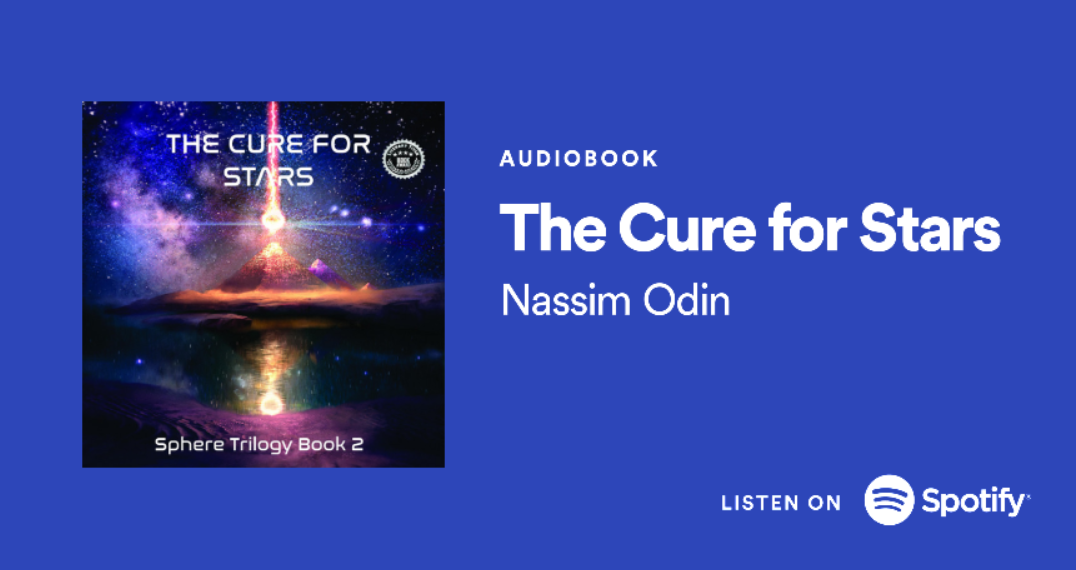The Cure for Stars
— book blurb —
One man. Two worlds. A million reasons to say no… but at what cost?
Al-Khidr was inside the Hall of Stars, and now he was moving inside a wormhole—a cosmic tunnel that opened up right above the Hall of Stars was spiraling down through galaxies like a coiled serpent from planet Lyra towards earth. He was unaware of the alien major General Hatathor who was also sucked into the wormhole due to his own act of charging sequence disruption. Where the wormhole was leading? None of them knew. But the one thing was sure to aliens was that the jump will now happen both in time and space.
WON LITERARY TITAN SILVER BOOK AWARD IN DECEMBER 2021
Buy from Amazon
Reviews
Literary Titan
The story is exhilarating, the setting is captivating and the addition of Hatathor makes this entry a little darker, violent and fun.
The Prairies Book Review
Highly impressive and exceptionally promising… Addictive.
Odin continues his gripping The Sphere of Destiny Trilogy with this exhilarating second installment. Al-Khidr thought he was inside the Hall of Stars but found himself moving inside a wormhole instead and landed on earth once again. And it’s not the same world he has left behind: times have changed and shifting political alliances have brought an entirely new era. Al-Khidr must find a cure for the Mutmut disease before time runs out. But with Hatathor on his trail, he needs to tread carefully. Odin has constructed a compelling tale of individual struggles, ambition, and regrets against a fantastically credible SF backdrop. The narrative is rounded and complete and Odin’s storytelling entertaining. He offers plenty of exhilarating moments as the plot snowballs toward a shocking, cliffhanger ending. The imaginative juxtaposition of historical setting and futuristic detail keeps the readers intrigued. Expertly blending elements of physics and soap opera, Odin’s SF tale is as entertaining as it is thought-provoking.
—————————————
Goodreads reviews
After The Sphere of Destiny, this next novel in the series takes us back to the planet Earth. Unfortunately for Al-Khidr it is not the Earth he originally left behind when he ventured off into the stars. Napoléon Bonaparte has invaded Egypt, and French troops are everywhere.
He uses cunning to befriend French scientist Vivant and the beautiful Estelle, a naturalist specialising in plants. Estelle offers to help Al-Khidr find the rare plant needed for the cure to Lyra’s Mutmut disease.
Al-Khidr is unaware Hatathor has followed him through the wormhole and has lost his own Jump-sphere. Now Hatathor is desperate to kill Al-Khidr for two reasons, one for revenge, and two get the sphere that currently belongs to the human.
The Cure for Stars is entertaining and interesting on a more intellectual level as Al-Khidr uses religion and politics to achieve his aims. There is a great deal of dialogue in this novel, much more so than in the previous book. This was caused not only by the previously mentioned religion and politics but the romance that was brewing continuously between Al-Khidr and Estelle. The novel also employs multiple narrators, which may not be to everyone’s taste.
There is a great deal of action, especially concerning the French troops. The author’s descriptions of battles and fight scenes are very vivid and not for the squeamish. This is made particularly evident when Hatathor gets involved. Hatathor seems to lack any sort of morals, and then he jumps up and surprises you. His demented and warped character steals the show in the way he is relentless in his pursuit of Al-Khidr. His violent tendencies make this novel slightly darker.
Al-Khidr has the usual human strengths, and weaknesses you would expect from the main protagonist, but his naivety exasperates me a little. How can a person be so clever one second and so dumb the next? (Answers on a postcard please, and Cabinet Ministers do not count.)
All the Arabic names (exceedingly long), words, and expressions have the translations written in brackets next to them which is a massive help. The author’s descriptive writing is excellent, and his research has been done well.
In a historical sense, The Cure for Stars is an interesting and intelligent read. But the Science-Fiction element is lacking, and I missed Nefertiti, and I hope we get to meet her in book three. (Pretty sure that is a nailed-on certainty.)
Listen on Spotify [link use with VPN=USA]
